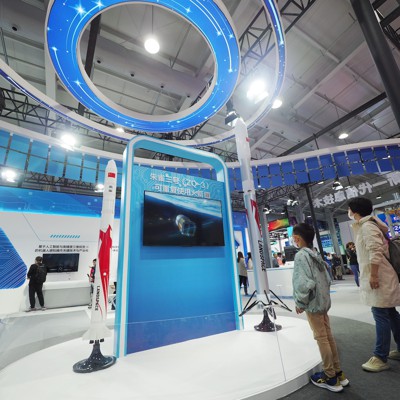On May 29, the Yuanxingzhe-1 suborbital rocket took off from a platform in the Yellow Sea, carrying with it not just the hopes of its maker—a Chinese commercial launch firm called Space Epoch—but also the prospects for China’s next phase in its space power.
The 64-meter rocket came to a hover about 2.5 km up, then landed vertically at the Oriental Spaceport in Haiyang, Shandong, marking the first known successful maritime vertical takeoff and vertical landing by a Chinese rocket company.
The test flight drew far less international coverage than, say, the pioneering SpaceX flights that preceded it. But it underscores China’s rapidly accelerating efforts to master reusable rocket technology. According to the company, the test verified guidance control, engine throttling, and sea-based recovery procedures for future reusable launch missions.
It also signals a strategic shift: Beijing is not only expanding its domestic space launch capacity, but also preparing a logistics backbone to support resilient, low-cost access to orbit that could reshape both commercial and military space operations.
China’s reusable-rocket objectives have expanded rapidly over the last five years, driven by both state-owned and private-sector space firms. Besides Space Epoch, there is Landscape, a 10-year-old, Beijing-based company whose Zhuque-2 became the world’s first methane-liquid oxygen rocket to reach space in 2023.
Its follow-on Zhuque-3 is designed for full-stage reusability. In September, the slender stainless-steel rocket launched from a remote expanse of China’s Gobi Desert, hovered in mid-air, and then descended vertically back to Earth, settling gently on its landing legs. With a 21.3-ton payload capacity and planned for the second half of 2025 and stage recovery targeted for 2026, Landspace is laying the foundation for a parallel architecture of low-cost, high-frequency launches that could transform both commercial and military space operations.
Yet another Chinese competitor is iSpace, whose Hyperbola-2 test vehicle performed a successful 1.5-kilometer vertical takeoff and landing in 2022. iSpace’s roadmap LinkSpace are investing in VTVL architecture at various stages of development.
Meanwhile, China’s state-owned aerospace giants are working on their own reusable rockets to support lunar exploration and the Chinese space station. China Aerospace Science and Technology Corporation, or CASC, is redesigning its super heavy-lift Long March 9 to include a reusable first stage. Test flights are expected later this decade.
By integrating private cargo systems into state-run infrastructure like the Tiangong space station, China is not just building new capability, but also accelerating a shift toward commercial participation in national space goals. Reusable rockets reduce launch costs and raise launch frequency, allowing for rapid fielding of satellite constellations. Frequent, cost-efficient missions using recycled boosters have already begun to revolutionize the commercial launch market.
China’s broader space ecosystem is surging beyond just these tests and plans. After a record 68 launch aboard the new Lijian-2 rocket in September. Tailored for rapid, time-sensitive scientific deliveries, Qingzhou and Haoloong will supplement the existing Tianzhou fleet, significantly improving delivery timelines and mission cadence.
While China’s progress is impressive, it still lags the United States, particularly SpaceX, which has launched more than 300 times. Landspace and other Chinese firms are still testing prototypes. If Landspace’s planned orbital flight and first-stage recovery are successful, that would still place China a few years behind SpaceX. However, reusability is more than just landing. It involves ground operations, manufacturing optimization, refurbishment cycles, and cost analysis, areas where SpaceX holds substantial institutional advantages.
China’s space sector also faces unique challenges. Regulatory oversight is tighter, commercial players are more intertwined with state policy, and the ecosystem of suppliers and launch infrastructure is still developing. Moreover, SpaceX enjoys a lead in global launch contracts, while China remains largely dependent on state-sponsored projects and domestic clients.
Nonetheless, China’s ability to close the gap should not be underestimated. The country’s space sector Technology-sharing with CASC and overlapping military-civil fusion projects give the country a potent ecosystem for space tech development.
With reusable systems in hand, Chinese firms will be able to deploy satellite constellations more rapidly and affordably, reshaping the global connectivity landscape. Guowang is a proposed 13,000-satellite low-Earth-orbit constellation, akin to SpaceX’s Starlink, intended to improve broadband coverage across China and the Global South. This looming shift carries deep implications, not only for the commercial satellite industry, but also for military capabilities and geopolitical influence.
Reusable rockets would planned International Lunar Research Station with Russia, will depend on launch systems that are both scalable and cost-effective.
The story of reusable rocket technology is frequently portrayed in the United States as being about innovation, personal prestige, or even the survival of humankind. For China, it is a strategic imperative. A tightly integrated system, in which new private firms operate with state backing and strategic alignment, aims to construct a resilient, scalable space logistics architecture for China. Its effect will be felt in not just markets, but in geopolitics and even warfare, both on Earth and in orbits beyond.
P.W. Singer is Strategist at New America and the author of multiple books on technology and security.
Alex Nova is a BluePath Labs associate and analyst specializing in emerging technologies, international affairs, and national security.
Read the full article here








Leave a Reply